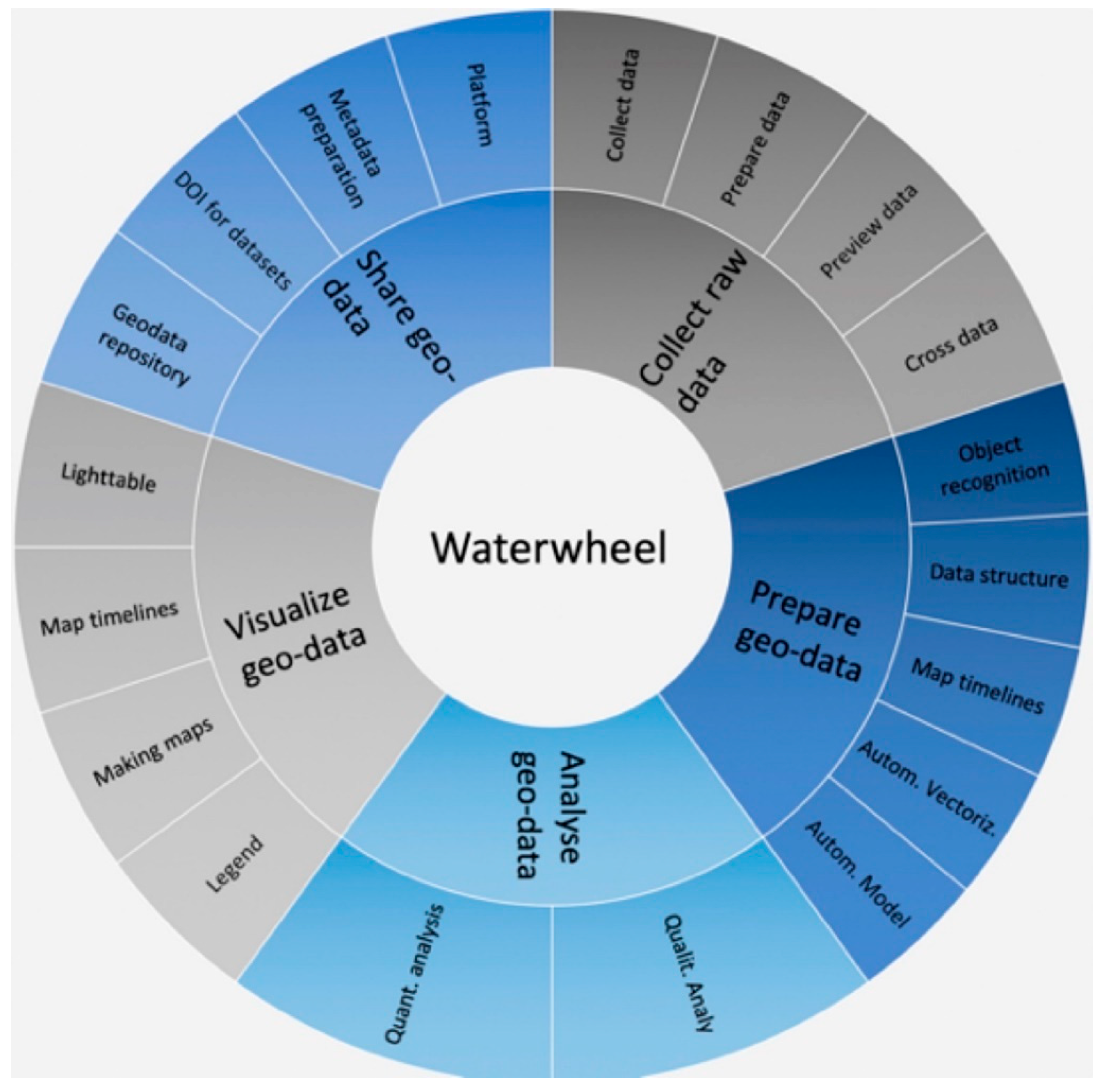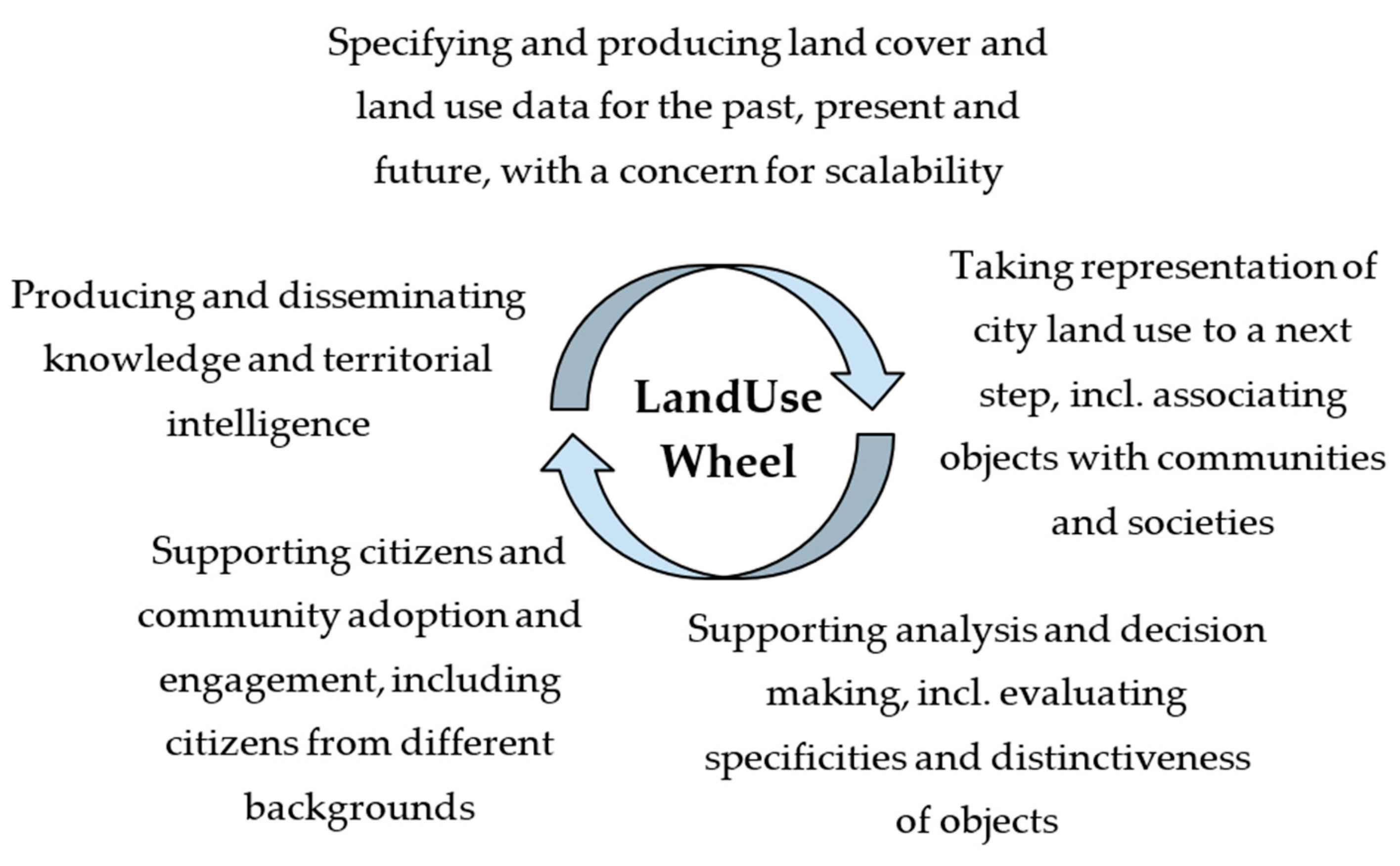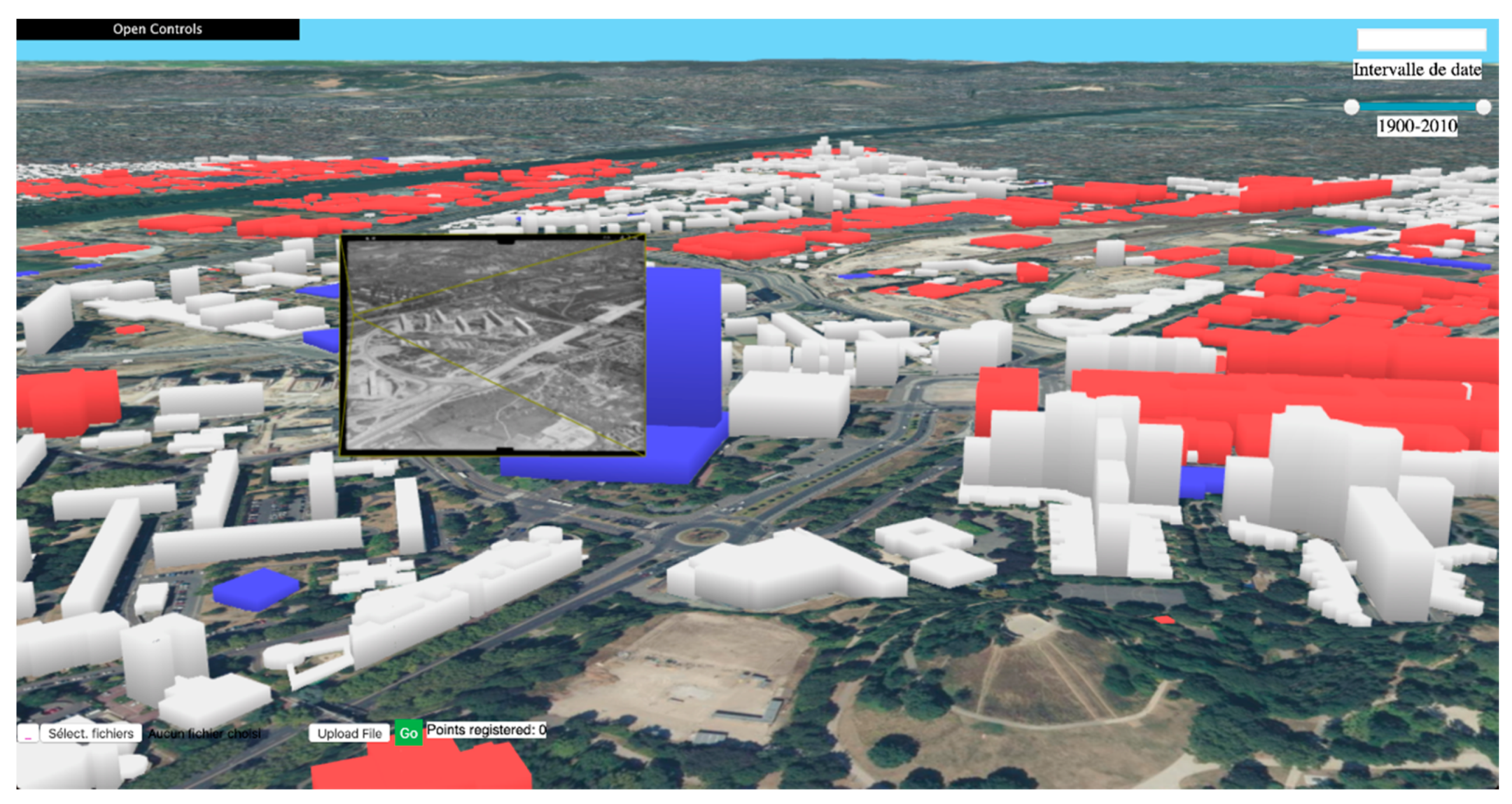Towards Culture-Aware Smart and Sustainable Cities: Integrating Historical Sources in Spatial Information Infrastructures
Abstract
:1. Introduction
2. Introducing a Target of Culture Awareness for Smart Cities
2.1. Context of the Research
2.2. The Field of Smart Cities in Search for More Synergy and Adoption
2.3. A Proposed Target of Cultural Awareness for City Information Infrastructures
The target “culture awareness of a city information infrastructure” is defined as follows: the capacity of a city information infrastructure to be used to associate an object of interest, within a city, to information accounting for the related societies, communities and cultural context, and to evaluate the specificities and distinctiveness of this object.
2.4. Application to Land Use
The target of the “culture awareness of a city information infrastructure with respect to land use” is defined as follows the capacity of a city information infrastructure to be used to associate a land use of interest to information accounting for the related societies, communities and cultural context, including technologies to create the land use model itself, and to evaluate its specificities and distinctiveness, in comparison with other land uses, other lands and other scales.
3. Cultivating Culture Awareness for Smart Cities’ Land Use Information Infrastructures: The LandUseWheel
3.1. Grounding Culture Awareness on Historical Data and a Junction between Past, Present and Future
3.2. Analysing Functions of Culture Aware Land Use Information Infrastructures: The LandUseWheel
3.2.1. Identifying High-Level Functionalities
3.2.2. Specifying and Producing Land Use Data and Metadata for the Past, Present and Future
3.2.3. Taking Representation of a City Land Use to a Next Step
- -
- The junction between the past, present, and future, within information infrastructures;
- -
- The creation of more-accurate models based on the integration of land cover and land use data available in the infrastructure;
- -
- The association of an object of interest with relevant communities and societies.
3.2.4. Supporting Analysis and Decision
- Put an object in perspective, by comparing it with other places, possibly distant in space and time;
- Detect unexpected behaviors and trends, and to understand dynamics;
- Obtain recommendations.
- Design benchmarks, obtain recommendations regarding specific land planning decisions, based on what has already been experienced elsewhere;
- Simulate a given land use taken from another place, for example, white roofs or cycling paths.
3.2.5. Enhance Citizen Engagement
3.2.6. Knowledge Production and Dissemination
3.3. Analyzing Technology Readiness of Multiple Modality and Metadata for Culture Awareness
3.3.1. Structuring Multimodal Content
3.3.2. Land Data Models and Knowledge Graph
3.3.3. Spatial Data Infrastructures and Metadata
4. Discussion
5. Conclusions
Author Contributions
Funding
Acknowledgments
Conflicts of Interest
References
- United Nations, Resolution Adopted by the General Assembly, 71/313. Work of the Statistical Commission Pertaining to the 2030 Agenda for Sustainable Development, 2017, A/RES/71/313. Available online: http://ggim.un.org/documents/A_RES_71_313.pdf (accessed on 1 September 2021).
- UNESCO. Culture|2030 Indicators; UNESCO: Paris, France, 2019; ISBN 978-92-3-200190-0. [Google Scholar]
- UNESCO. World Conference on Cultural Policies: Final Report, Mexico City. 1982. Available online: https://unesdoc.unesco.org/ark:/48223/pf0000052505 (accessed on 1 September 2021).
- Bucher, B.; Laurent, D.; Janssen, P. Preserving Semantics, Tractability and Evolution on a Multi-Scale Geographic Information Infrastructure: Cases for Extending INSPIRE Data Specifications, Report of Eurogeographics-EuroSDR Workshop on INSPIRE Data Extension. Available online: http://www.eurosdr.net/sites/default/files/uploaded_files/eurosdr_inspire_data_extension.pdf (accessed on 1 September 2021).
- Bucher, B.; Tiainen, E.; Ellett, T.; Acheson, E.; Laurent, D.; Boissel, S. Data Linking by Indirect Spatial Referencing Systems, EuroSDR Report. Available online: http://www.eurosdr.net/sites/default/files/uploaded_files/eurosdr_data_linking_by_indirect_spatial_referencing_systems.pdf (accessed on 1 September 2021).
- Masson, V.; Bocher, E.; Bucher, B.; Chitu, Z.; Christophe, S.; Fortelius, C.; Hamdi, R.; Lemonsu, A.; Perrels, A.; Van Schaeybroeck, B.; et al. The Urban Clim. Serv. URCLIM project. Clim. Serv. 2020, 20, 100194. [Google Scholar] [CrossRef]
- Hein, C.; Azman, L.; van Mil, Y. The Waterwheel: A Socio-spatial method for Understanding and Displaying Holistic Water Systems. In Proceedings of the PreConference “Water, Megacities and Global Change”, Paris, France, 7–11 December 2020; Available online: https://en.unesco.org/sites/default/files/hein.pdf (accessed on 1 September 2021).
- Gominski, D.; Gouet-Brunet, V.; Chen, L. Connecting Images through Sources: Exploring Low-data, Heterogeneous Instance Retrieval. Remote Sens. J. 2021, 13, 3080. [Google Scholar] [CrossRef]
- Blettery, E.; Lecat, P.; Devaux, A.; Gouet-Brunet, V.; Saly-Giocanti, F.; Bredif, M.; Delavoipiere, L.; Conord, S.; Moret, F. A spatio-temporal web-application for the understanding of the formation of the Parisian metropolis. In Proceedings of the 3D GeoInfo 2020 Conference, ISPRS Annals of Photogrammetry, Remote Sensing and Spatial Information Sciences, London, UK, 7–11 September 2020; pp. 45–52. [Google Scholar]
- Verwayen, H.; Fallon, J.; Gouet-Brunet, V.; Raines, D.; Noordegraaf, J.; de Keulenaar, E.; Meysman, S.; Sommersguter, P.; Oomen, J.; Bocyte, R.; et al. Exploitation Avenues (Pillar 3) Roadmap, Deliverable D4.2, CSA Time Machine, March 2020. Available online: https://www.timemachine.eu/wp-content/uploads/2020/07/D4.2_TM_CSA_Exploitation-Avenues_P3_Roadmap_v3.2.pdf (accessed on 1 September 2021).
- Hollands, R.G. Will the real smart city please stand up? City 2008, 12, 303–320. [Google Scholar] [CrossRef]
- Brauer, B.; Eisel, M.; Kolbe, T.; Lutz, M. The State of the Art in Smart City Research—A Literature Analysis on Green IS Solutions to Foster Environmental Sustainability. In Proceedings of the PACIS 2015 Proceedings, Singapore, 5–9 July 2015; p. 74. Available online: https://aisel.aisnet.org/pacis2015/74 (accessed on 1 September 2021).
- Mohanty, S.P.; Choppali, U.; Kougianos, E. Everything You wanted to Know about Smart Cities. IEEE Consum. Electron. Mag. (CEM) 2016, 5, 60–70. [Google Scholar] [CrossRef]
- Caragliu, A.; Del Bo, C.; Nijkamp, P. Smart cities in Europe. J.Urb. Technol. 2011, 18, 65–82. [Google Scholar] [CrossRef]
- Ye, L.; Mandpe, S.; Meyer, P. What is “Smart Growth”—really? J. Plan. Lit. 2005, 19, 301–315. [Google Scholar] [CrossRef]
- Ravetz, J. From ‘Smart’ City to ‘Wise’: Synergistic Pathways for Collective Urban Intelligence. In JPI Urban Europe Urban Transition Pathways Symposium; Urban Europe: Vienna, Austria, 2017; Available online: https://jpi-urbaneurope.eu/wp-content/uploads/2017/04/Ravetz_From-smart-to-wise.pdf (accessed on 1 September 2021).
- Recommendation ITU-T Y.4900/L.1600 (2016) Overview of Key Performance Indicators in Smart Sustainable Cities. Available online: https://www.itu.int/rec/T-REC-L.1600-201606-I (accessed on 1 September 2021).
- ISO 37122:2019. Sustainable Cities and Communities—Indicators for Smart Cities; ISO: Geneva, Switzerland , 2019; 95p. [Google Scholar]
- ISO 37106:2018. Sustainable Cities and Communities—Guidance on Establishing Smart City Operating Models for Sustainable Communities; ISO: Geneva, Switzerland , 2018; 14p. [Google Scholar]
- Walter, C. Future Trends in Geospatial Information Management: The Five to Ten Year Vision, 3rd ed.; Available online: https://ggim.un.org/meetings/GGIM-committee/10th-Session/documents/Future_Trends_Report_THIRD_EDITION_digital_accessible.pdf (accessed on 1 September 2021).
- Anderson, A. The Art of Smart Cities. Available online: http://www.internationalartsmanager.com/blog/the-art-of-smart-cities.html (accessed on 30 June 2020).
- Batty, M. Inventing Future Cities; MIT Press: Cambridge, MA, USA, 2018. [Google Scholar]
- Laurini, R.; Servigne, S.; Favetta, F. About Territorial Intelligence and Geographic Knowledge Bases. Cuad. de Adm. 2020, 33, 12. [Google Scholar] [CrossRef]
- Hunt, D.; Rogers, C.; Cavada, M. Smart Cities: Contradicting Definitions and Unclear Measures. In Proceedings of the 4th World Sustainability Forum, Basel, Switzerland, 1–30 November 2014; pp. 1–12. [Google Scholar] [CrossRef]
- Tylor, E.B. Primitive Culture, Research into the Development of Mythology, Philosophy, Religion, Language, Art and Custom; G.P. Putnam’s Son: New York, NY, USA, 1871; Volume 1. [Google Scholar]
- Hanseth, O. From Systems and Tools to Networks and Infrastructures—From Design to Cultivation: Towards a design Theory of Information Infrastructures. In Industrial Informatics Design, Use and Innovation; Jonny, H., Ed.; IGI Global: Hershey, PA, USA, 2010; pp. 122–156. ISBN 978-1-61520-692-6.11. [Google Scholar]
- Venice’s Mose High Water Barrier Could Grant the Survival of the City. Available online: https://www.wantedinmilan.com/news/venices-mose-keeping-the-floating-city-from-washing-away.html (accessed on 4 February 2021).
- Hein, C.; Schubert, D. Resilience and Path Dependence–A comparative study of the port cities of London, Hamburg and Philadelphia. J. Urb. Hist. 2020, 47, 389–419. [Google Scholar] [CrossRef]
- Alberti, V.; Alonso Raposo, M.; Attardo, C.; Auteri, D.; Ribeiro Barranco, R.; Batista, E.; Silva, F.; Benczur, P.; Bertoldi, P.; Bono, F.; et al. The Future of Cities; Publications Office of the European Union: Luxembourg, 2019; ISBN 978-92-76-03848-1. JRC116711.; EUR 29752 EN. [Google Scholar] [CrossRef]
- JPI Cultural Heritage, The Joint Programming Initiative on Cultural Heritage and Global Change: A New Challenge for Europe —Vision Document, Rome. 2010. Available online: https://www.heritageresearch-hub.eu/app/uploads/JPI_only/Documents/Vision-Document_25.5.2010.pdf (accessed on 1 September 2021).
- European Parliament; Council of the European Union. Directive 2007/2/EC Establishing an Infrastructure for Spatial Information in the European Community (INSPIRE). Available online: http://data.europa.eu/eli/dir/2007/2/oj. (accessed on 1 June 2020).
- Ellis, E. Land-use and Land-Cover Change, in The Encyclopedia of Earth. Available online: https://editors.eol.org/eoearth/wiki/Land-use_and_land-cover_change (accessed on 1 June 2020).
- Ažman Momirski, L.; Van Mil, Y.; Hein, C. Straddling the Fence: Land Use Patterns in and around Ports as Hidden Designers. Urban Plan. 2021, 6, 136–151. Available online: https://www.cogitatiopress.com/urbanplanning/article/view/4101/4101 (accessed on 1 September 2021). [CrossRef]
- Guldi, J.; Armitage, D. The History Manifesto; Cambridge University Press: Cambridge, UK, 2014. [Google Scholar]
- Canal, E. Archeologia Della Laguna Di Venezia 1960–2010; Cierre Edizioni: Sommacampagna, Italy, 2015. [Google Scholar]
- Alfasi, N.; Almagor, J.; Benenson, I. The actual impact of comprehensive land-use plans: Insights from high resolution observations. Land Use Policy 2012, 29, 862–877. [Google Scholar] [CrossRef]
- Benzerzour, M.; Masson, V.; Groleau, D.; Lemonsu, A. Simulation of the Ur-ban Climate Variations in Connection with the Transformations of the City of Nantes since the 17th Century. Build. Environ. 2011, 46, 1545–1557. [Google Scholar] [CrossRef]
- Opll, F. The European Atlas of Historic Towns. Project, Vision, Achievements. Open Ed. J. 2011, 60, 169–182. [Google Scholar] [CrossRef]
- Bucher, B.; Tiainen, E.; Ellett von Brasch, T.; Janssen, P.; Kotzinos, D.; Čeh, M.; Rijsdijk, M.; Folmer, E.; van Damme, M.-D.; Zhral, M. Conciliating Perspectives from Mapping Agencies and Web of Data on Successful European SDIs: Toward a European Geographic Knowledge Graph. ISPRS Int. J. Geo-Inf. 2020, 9, 62. [Google Scholar] [CrossRef] [Green Version]
- Zrhal, M.; Bucher, B.; Van Damme, M.-D.; Hamdi, F. Spatial dataset Search: Building a Dedicated Knowledge Graph. AGILE GISci. Ser. 2011, 2, 43. [Google Scholar] [CrossRef]
- Kokla, M.; Guilbert, E. A Review of Geospatial Semantic Information Modeling and Elicitation Approaches. ISPRS Int. J. Geo-Inf. 2020, 9, 146. [Google Scholar] [CrossRef] [Green Version]
- Stewart, I.D.; Oke, T.R. Local Climate Zones for Urban Temperature Studies. Bull. Am. Meteorol. Soc. 2012, 93, 1879–1900. [Google Scholar] [CrossRef]
- Costes, B.; Perret, J.; Bucher, B.; Gribaudi, M. An aggregated graph to qualify historical spatial networks using temporal patterns detection. In Proceedings of the18th AGILE International Conference on Geographic Information Science, Lisboa, Portugal, 9–12 June 2015. [Google Scholar]
- Datta, R.; Joshi, D.; Li, J.; Wang, J.Z. Image Retrieval: Ideas, Influences, and Trends of the New Age. ACM Comput. Surv. 2008, 40. [Google Scholar] [CrossRef]
- Tyagi, V. Content-Based Image Retrieval: Ideas, Influences, and Current Trends; Springer Publishing Company: Berlin, Germany, 2018. [Google Scholar]
- Piasco, N.; Sidibé, D.; Demonceaux, C.; Gouet-Brunet, V. A survey on Visual-Based Localization: On the benefit of heterogeneous data. Pattern Recognit. 2018, 74, 90–109. [Google Scholar] [CrossRef] [Green Version]
- Benavent, X.; Garcia-Serrano, A.; Granados, R.; Benavent, J.; de Ves, E. Multimedia information retrieval based on late semantic fusion approaches: Experiments on a wikipedia image collection. IEEE Trans. Multimed. 2013, 15, 2009–2021. [Google Scholar] [CrossRef] [Green Version]
- ImageCLEF Benchmark. Available online: http://www.imageclef.org (accessed on 1 September 2021).
- Kim, S.; Min, D.; Ham, B.; Ryu, S.; Do, M.N.; et Sohn, K. DASC: Dense Adaptive Self-Correlation descriptor for multi-modal and multi-spectral correspondence. In Proceedings of the IEEE Conference on Computer Vision and Pattern Recognitiom, Boston, MA, USA, 7–12 June 2015. [Google Scholar]
- Khokhlova, M.; Gouet-Brunet, V.; Abadie, A.; Chen, L. Cross-year multi-modal image retrieval using siamese networks. In Proceedings of the ICIP 2020—7th IEEE International Conference on Image Processing, Abou Dhabi, United Arab Emirates, 25–28 October 2020. [Google Scholar]
- Song, J.; Yang, Y.; Yang, Y.; Huang, Z.; Shen, H.T. Inter-media hashing for large-scale retrieval from heterogeneous data sources. In Proceedings of the 2013 ACM SIGMOD International Conference on Management of Data, New York, NY, USA, 22–27 June 2013; pp. 785–796. [Google Scholar]
- Gominski, D.; Poreba, M.; Gouet-Brunet, V.; Chen, L. Challenging deep image descriptors for retrieval in heterogeneous iconographic collections. In Proceedings of the 1st Workshop on Structuring and Understanding of Multimedia, Nice, France, 21 October 2019. [Google Scholar]
- Devos, W.; Milenov, P. Applying tegon, the elementary physical land cover feature, for data interoperability. In Land Use and Land Cover Semantics: Principles, Best Practices and Prospects; LLC Publication: New York, NY, USA; Taylor and Francis Group: Milton, UK, 2015; ISBN 9781482237399. [Google Scholar]
- Lacuna, M.-L.; López-Ibáñez, M.-B. Smart Urban Planning: Designing Urban Land Use from Urban Time Use. J. Urb. Technol. 2014, 21, 39–56. [Google Scholar] [CrossRef]
- Arif, H.; Cole, R.J.; Cole, I.A. Experiments with Smart Zoning for Smart Cities. In Smart Cities as Democratic Ecologies; Araya, D., Ed.; Palgrave Macmillan: London, UK, 2015. [Google Scholar] [CrossRef]
- Cheatham, M.; Krisnadhi, A.; Amini, R.; Hitzler, P.; Janowicz, K.; Shepherd, A.; Narock, T.; Jones, M.; Peng, J. The GeoLink knowledge graph. Big Earth Data 2018, 2, 131–143. [Google Scholar] [CrossRef]
- Bernard, L.; Craglia, M.; Gould, M.; Kuhn, W. Towards an SDI research agenda. In Proceedings of the 11th EC GIS and GIS Workshop-ESDI, Alghero, Italy, 29 June–1 July 2005. [Google Scholar]
- Masser, I.; Crompvoets, J. Building European Spatial Data Infrastructures; Esri Press: Redlands, CA, USA, 2015; p. 100. [Google Scholar]
- Kotsev, A.; Minghini, M.; Tomas, R.; Cetl, V.; Lutz, M. From Spatial Data Infrastructures to Data Spaces—A Technological Perspective on the Evolution of European SDIs. ISPRS Int. J. Geo-Inf. 2020, 9, 176. [Google Scholar] [CrossRef] [Green Version]
- Probst, F. An Ontological Analysis of Observations and Measurements. In Proceedings of the 4th International Conference on Geographic Information Science (GIScience), Münster, Germany, 20–23 September 2006. [Google Scholar]
- Abadie, N.; Mechouche, A.; Mustière, S. OWL based formalisation of geographic databases specifications. In Proceedings of the 17th International Conference on Knowledge Engineering and Knowledge Management (EKAW’10), Lisbon, Portugal, 11–15 October 2010. [Google Scholar]
- Holtorf, C. Embracing change: How cultural resilience is increased through cultural heritage. World Archaeol. 2018, 50, 639–650. [Google Scholar] [CrossRef]



| 1. Specifying and producing land use data and metadata for the past, present and future |
|
| 2. Taking representation of a city to a next step |
|
| 3. Enhancing analysis, especially of specificities and distinctiveness, and decision capacities |
|
| 4. Enhance citizen and community adoption and engagement |
|
| 5. Support knowledge production and dissemination, and territorial intelligence |
|
Publisher’s Note: MDPI stays neutral with regard to jurisdictional claims in published maps and institutional affiliations. |
© 2021 by the authors. Licensee MDPI, Basel, Switzerland. This article is an open access article distributed under the terms and conditions of the Creative Commons Attribution (CC BY) license (https://creativecommons.org/licenses/by/4.0/).
Share and Cite
Bucher, B.; Hein, C.; Raines, D.; Gouet Brunet, V. Towards Culture-Aware Smart and Sustainable Cities: Integrating Historical Sources in Spatial Information Infrastructures. ISPRS Int. J. Geo-Inf. 2021, 10, 588. https://doi.org/10.3390/ijgi10090588
Bucher B, Hein C, Raines D, Gouet Brunet V. Towards Culture-Aware Smart and Sustainable Cities: Integrating Historical Sources in Spatial Information Infrastructures. ISPRS International Journal of Geo-Information. 2021; 10(9):588. https://doi.org/10.3390/ijgi10090588
Chicago/Turabian StyleBucher, Bénédicte, Carola Hein, Dorit Raines, and Valérie Gouet Brunet. 2021. "Towards Culture-Aware Smart and Sustainable Cities: Integrating Historical Sources in Spatial Information Infrastructures" ISPRS International Journal of Geo-Information 10, no. 9: 588. https://doi.org/10.3390/ijgi10090588







